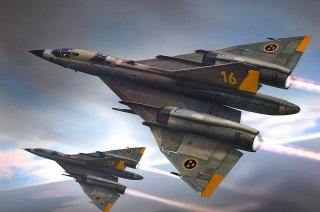This Nuclear Bomber Was Impressive Looking: It Was Never Built (And It Was Not American)
Sweden came up with the idea.
Key Point: Sweden wanted a nuclear bomber to defend itself. Here is the history of that shelved program.
After the Second World War, Sweden initiated a clandestine nuclear program — and had plans for a supersonic nuclear bomber.
This first appeared in 2020 and is being reposted due to reader interest.
Atoms for Peace
After World War II, the Soviet specter lay heavily across Europe. Like other post-war countries, Sweden wanted to protect itself from a Soviet invasion — and decided to manufacture nuclear weapons to ensure its security.
Initially, Sweden tried to get nuclear weapons expertise from outside the country. The United States, as the world’s first nuclear power and a guarantor of European security, was a logical partner.
In the early days of the Cold War, the United States pursued a strategy of promoting nuclear power for energy production — President Eisenhower’s “Atoms for Peace” concept. Nuclear material and nuclear know-how would only be transferred to foreign governments on the condition that the nuclear research and development would only be for peaceful purposes, precluding weapon’s research. Sweden declined.
Buying nuclear weapons directly from the United States was also an unattractive option for Sweden most likely impossible.
Luckily for the Swedes, Uranium-containing shale is abundant in Sweden.
Bombs Away
By the mid-1960s, Sweden has enough fissile material to build a bomb in six months. It just needed a platform to deliver nuclear payload — the Saab 36.
The Saab 36 was a twin-engine supersonic bomber. It would have had delta wings, and fly in the Mach 2+ range. Flight ceiling was to be 18,000 meters or 60,000 feet.
Targets of value to Sweden were in the Baltic — the Baltic countries of Latvia, Estonia, and Lithuania are just across the Baltic Sea, and Poland and East Germany are also practically next door to Sweden. (Though the Cold War is over, the Baltic is still an area of concern for Sweden.)
The Saab 36 had to deal with a few design restrictions which would affect its payload.
Designers at Saab were concerned that the weapons externally attached to the fuselage or wings would create drag, degrading the jet’s performance. The high Mach 2+ speed would also have generated a large amount of heat that could damage weapons — or worse cause them to “cook-off” or accidentally explode.
Bombs would have to be stored internally in an enclosed weapons bay, farther away from potentially dangerous high temperatures. Internal space would be at a premium, and there would only be space for a single 800 kilogram, or 1,800 pound, free-falling nuclear bomb, reducing the efficacy of the bomber, and limiting its use to a tactical weapon delivery system rather than a strategic deterrent.
The Saab 36 got off the drawing board just as a simple wind tunnel mockup and the design was not finalized. Images online appear to show two different designs, one with a chin-mounted engine intake, and another with two jet engines integrated in the delta wing.
Postscript
Though the bomber never entered serial production, work on the Saab 36 contributed in part to the development of the Saab 37, a strike fighter that was one of the first successful jets that incorporated the delta wing design.
The Swedish Parliament, the Riksdag, would renounce nuclear weapons in 1968, and Sweden would abandon its nuclear ambitions in the early 1970s, shipping fissile material abroad. The Saab 36 would never fly.
Caleb Larson is a Defense Writer with The National Interest. He holds a Master of Public Policy and covers U.S. and Russian security, European defense issues, and German politics and culture.
This first appeared in 2020 and is being reposted due to reader interest.
More From The National Interest:
Russia Has Missing Nuclear Weapons Sitting on the Ocean Floor

